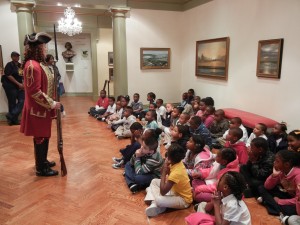The Art of Diplomacy & Georgia Performance Standards
FIFTH GRADE
SS5H6 The student will explain the reasons for America’s involvement in World War II
- Describe Germany’s aggression in Europe and Japan’s aggression in Asia.
- Describe major events in the war in both Europe and the Pacific; include Pearl Harbor, Iwo Jima, D-Day, VE and VJ Days, and the Holocaust.
- Discuss President Truman’s decision to drop the atomic bombs on Hiroshima and Nagasaki.
- Identify Roosevelt, Stalin, Churchill, Hirohito, Truman, Mussolini, and Hitler.
- Describe the effects of rationing and the changing role of women and African- Americans; include “Rosie the Riveter” and the Tuskegee Airmen.
- Explain the U.S. role in the formation of the United Nations.
SIXTH GRADE
SS6H7 The student will explain conflict and change in Europe to the 21st century
- Explain the impact of WWII in terms of the Holocaust, the origins of the Cold War, and the rise of Superpowers.
EIGHTH GRADE
SS8H9 The student will describe the impact of World War II on Georgia’s development economically, socially, and politically.
- Describe the impact of events leading up to American involvement in World War II; include Lend-Lease and the bombing of Pearl Harbor.
- Evaluate the importance of Bell Aircraft, military bases, the Savannah and Brunswick shipyards, Richard Russell, Carl Vinson, and Franklin Roosevelt who lived part time in Georgia.
- Explain the impact of the Holocaust on Georgians.
SS8H10 The student will evaluate key post-World War II developments of Georgia from 1945 to 1970
- Analyze the impact of the transformation of agriculture on Georgia’s growth.
- Explain how the development of Atlanta, including the roles of mayors William B. Hartsfield and Ivan Allen, Jr., and major league sports, contributed to the growth of Georgia.
- Discuss the impact of Ellis Arnall.
NINTH — TWELFTH GRADE
SSWH18 The student will demonstrate an understanding of the global political, economic, and social impact of World War II.
- Describe the major conflicts and outcomes; include Pearl Harbor, El-Alamein, Stalingrad, D-Day, Guadalcanal, the Philippines, and the end of the war in Europe and Asia.
- Identify Nazi ideology, policies, and consequences that led to the Holocaust.
- Explain the military and diplomatic negotiations between the leaders of Great Britain (Churchill), the Soviet Union (Stalin), and the United States (Roosevelt/Truman) from Teheran to Yalta and Potsdam and the impact on the nations of Eastern Europe.
- Explain allied Post-World War II policies; include formation of the United Nations, the Marshall Plan for Europe, and MacArthur’s plan for Japan.
SSUSH19 The student will identify the origins, major developments, and the domestic impact of World War II, especially the growth of the federal government.
- Explain A. Philip Randolph’s proposed march on Washington, D.C., and President Franklin D. Roosevelt’s response.
- Explain the Japanese attack on Pearl Harbor and the internment of Japanese- Americans, German-Americans, and Italian-Americans.
- Explain major events; include the lend-lease program, the Battle of Midway, D-Day, and the fall of Berlin.
- Describe war mobilization, as indicated by rationing, war-time conversion, and the role of women in war industries.
- Describe the Manhattan Project at Los Alamos and the scientific, economic, and military implications of developing the atomic bomb.
- Compare the geographic locations of the European Theater and the Pacific Theater and the difficulties the U.S. faced in delivering weapons, food, and medical supplies to troops.
The Art of Diplomacy can help students develop critical thinking and information processing skills, including:
- Bridge essential understanding about past events
- Understand the nature of historical inquiry
- Encourage the consideration of multiple perspectives on events
- Engage in speculation about the known and unknown motives and actions of historic figures
- Integrate the strands of Social Studies and Art

